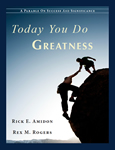Great piece!
Expired- Details
- Written by: Erwin
Rex M Rogers Testimony Of Faith
Expired- Details
- Written by: Rex M. Rogers
I grew up in a small, southeastern Ohio town—“3,000 friendly people,” the sign said at the village limits. I was surrounded by an extended family in which virtually everyone was a believer in Christ and who, for the most part, practiced their faith. I didn’t know it then, but I now understand that this family experience was a rare gift.
Both of my parents are dedicated Christian people and have been since before I was born. Mom was a piano and organ teacher, who has participated in church music and worship services since her teens. Dad was a factory worker and barber and a member of my home church deacon board for over forty years, leading it for much of this time. When the church doors were open, so to speak, we were there. And when they weren’t open, Dad and Mom were still there, laboring faithfully behind the scenes—Dad fixing or preparing whatever needed attention, Mom leading music practices with others.
So it’s not a stretch to say my sister and I come from, in the best sense of the term, a “Christian home.” In response to the witness of my parents and many others in the church, at six years of age I made a personal profession of faith in Jesus Christ as my Savior, following this with baptism some three years later.
All four of my grandparents lived nearby and all of them played a role in my upbringing. They were caring and loving, wise, optimistic, modeled incredible work ethics, and “finished well,” living consistent, admirable Christian lives till the Lord called them home. Each one made spiritual and life investments in me that I cannot possibly repay other than by attempting to live by their example and live up to their expectations.
My maternal grandfather was the lively, hilarious spiritual patriarch of the family, and to a considerable extent of many families within our community. He was also a leading deacon in our Baptist church. He and my grandmother, along with three or four other couples, had made the difficult choice years before to leave their church, which had begun drifting into theological liberalism, and to found a new church committed to the Lord and the Word of God. I was a direct spiritual beneficiary of their courage, decisions, and diligent efforts, and so are other generations in a church that yet thrives after their passing.
In my family I learned and I believe that Jesus is the Way, the Truth, and the Life, and the Bible is God’s inerrant Word, our guide for faith and practice. As a young person I attended Sunday School, daily vacation Bible school, church camp, Jet Cadets, and Teens for Christ. You name it, I was there. I was no angel, but I did everything a kid from a Christian home and a fundamentalist church was supposed to do. Then I attended a Christian college, now called Cedarville University.
Aside from a Christian family upbringing nothing marked my life more than my undergraduate experience. I loved every minute of it. While I was in college God delivered me from a spiritual struggle. Early in my Christian life, given a strongly rationalistic mind, I wrestled with doubt—not in the existence of God but in whether or not I was truly saved. My struggle ended with the assurances I found in 2 Timothy 2:11-13. Later, I discovered others who struggled with doubt, so as one outcome of my spiritual journey I’ve often spoken about doubt with college students and others, using Os Guinness’s work on the subject as one key supporting source.
It was also in Christian college that I found and pursued what became a wonderfully liberating understanding of the Christian faith, what we at that time called “a Christian theistic world-life view.” My growing understanding of a biblically-based Christian philosophy of life gradually allowed me to set aside certain fears, undeveloped views, or limited understandings rooted in my good but sometimes legalistic church experience in favor of a still thoroughly biblical but culture-engaging, forward thinking perspective of life.
Dr. Francis A. Schaeffer began writing his influential books just before my college years and continued for a decade or so after I graduated. His books helped me look more confidently upon the world, life, and learning, knowing the Christian faith offered “true truth,” as he called it. Through my education and via Dr. Schaeffer’s books I was intellectually set free, for I realized that one need not fear learning something that would someday undermine one’s faith. The Christian faith, I learned and internalized, was as intellectually sound as it was spiritually trustworthy.
My Christian college years also provided me with an attraction to the teaching profession and Christian higher education and with a friend who would become my wife.
Years hence I was finally able to write what I consider something of a personal manifesto, Christian Liberty: Living for God in a Changing Culture (Baker Books, 2003), which has since been republished as an ebook, Living for God in Changing Times (Unlikely Leaders, 2011). This book expresses my understanding of how to apply a biblically Christian worldview so one may live “in the world” while being “not of the world,” yet remembering God said to go “into the world.” I believe regular prayer and Bible reading are important ways in which we may and should develop our relationship with the Lord and through which the Spirit of God enables us to live a life characterized by personal holiness.
I am theologically conservative and consider myself a conservative evangelical, though I understand the definitions of these terms are moving targets. Sometimes today I simply say I am a Christian or follower of Jesus. I’m an optimistic realist, which I believe every Christian should be. We embrace God’s providence and know the end of the story, yet we understand the reality of sin in our lives and the impact of evil in the world. God calls us to serve him now, to contribute, to build culture for his glory, to witness to saving faith in Jesus, and to proclaim the Lordship of Christ in all of life. Our faith is eternally contemporary and transformative. All of this is one reason “proactive” is my favorite word.
Sarah and I were married in 1974 and God later blessed us with four children, now adults, and later still with their spouses and four grandchildren. Sarah is a wonderfully gracious believer who uses her gifts, especially hospitality, to bless me, our family, our friends, and many more. She has always served the Lord and has stood beside me as a partner in ministry, but now in our empty-nest years she is even more engaged in volunteer support in missions—Women At Risk, International.
The Lord guided us in attaining advanced degrees, through some thirty-four years of service in Christian education, including 17 years with Cornerstone University, several months in consulting, and now service in missions, doing promotion and fundraising for SAT-7 USA. God has given me opportunities to teach, speak, write, and lead. For as long as he gives me, my aspirations are to honor the Lord by honoring my wife and family, to serve proactively with integrity and vigor in whatever organizations or contexts he places me, and to someday finish well.
For all of this Sarah and I praise God and remember our family verse chosen when we knew our first baby was on the way: “The Lord has done great things for us, and we are filled with joy” (Psalm 126:3).
© Rex M. Rogers – All Rights Reserved, 2011
*This blog may be reproduced in whole or in part with a full attribution statement. Contact Rex or read more commentary on current issues and events at www.rexmrogers.com or follow him at www.twitter.com/RexMRogers.
- Details
- Written by: Rex M. Rogers
Last winter I began to feel like I was behind the curve on some things that seemed to me to be important to what I am supposed to do professionally. So since that time I've tried to learn a few "new media" and "social media" skills, among them how to:
--shoot and edit video in iMovie, then post it on YouTube,
--develop a YouTube or Vimeo channel,
--post audio and video files on websites or in emails,
--develop video blogs - "vlogs,"
--use website content management systems,
--burn CD or DVDs, including construct menus – yep, I'd never done this, but I have now,
--use Twitter, HootSuite or TweetDeck etc, iTunes, or construct/launch cause-related Facebook pages,
--use QR codes,
--use eReaders like Nook or Kindle, or use ebook software like iBooks, Kindle, Adobe Digital Editions,
--construct and use e-applications of audiobooks,
--acquire ISBN numbers for books and ebooks,
--construct ebooks, and then post, market, and sell them on Amazon Kindle.
I write this not to brag but to say it's been fun and productive. And more importantly, to suggest that I believe all of us should keep learning as much as we can about new/social media. Why? The more we know the better and more knowledgeably we can interact with our children, grandchildren, and culture.
I'm not a pro on any of this. But like learning PowerPoint a few years back, learning how to do basics gives me more freedom in my work and helps me talk to people who know more, so I can ask them to create what I need.
In addition, in the past couple of months I've gotten close-in looks at a couple of other ministry organizations. And frankly, I was amazed to discover how uninformed, unprepared, "behind," and thus unable most of the staff were in terms of new or social media. They didn't know how to do or use much of anything, and I thought then that our staff at SAT-7 USA could run circles around them. But of course we all need to keep learning.
So I write this piece not with an action plan or a to-do list but to encourage you to keep looking for ways to learn to do "new things." The learning curve might sometimes be taxing, but the end result will almost always enrich your professional experience, benefit you personally, and certainly benefit the ministry.
BTW, the old educator in me thinks that one of the things we're going to be doing for eternity in heaven is…learning. Think about it: we're going to hang out with the Omniscient Sovereign God who is never going to run out of cool things to teach us. We're going to learn, which is to say we’re going to go to school forever. Sounds good to me.
© Rex M. Rogers – All Rights Reserved, 2011
*This blog may be reproduced in whole or in part with a full attribution statement. Contact Rex or read more commentary on current issues and events at www.rexmrogers.com or follow him at www.twitter.com/RexMRogers.
- Details
- Written by: Rex M. Rogers
I am pleased to announce the publication of my second ebook, Today You Do Greatness: A Parable On Success And Significance, co-authored with Dr. Rick E. Amidon. Dr. Amidon is Founder, mark217, and former president, Baker College of Muskegon and Sanford-Brown College. (The ebook is available for $2.99 via the title link to Amazon.com.)
This ebook is a parable about greatness, leadership, faith, and life portrayed in a short story about an immigrant whose memories include a father who encouraged him to “do greatness.” The new American obtains an education, finds a profession, works diligently, and matures.
Our ebook emerges from the fact that all people possess a philosophy of life informing what values they embrace, what choices they make, and who they become. In this story, our immigrant friend does “his thing” based upon the philosophy of life he inherited.
But he eventually faces inevitable questions: Has his quest for success really led him to a life of true significance? Are success and significance opposed to each other – or can he have both?
To probe and hopefully answer these questions we’ve included alongside the parable parallel commentary rooted in a Christian philosophy of life, greatness, and leadership, which is distilled in snippets of biblically based application. By comparing and contrasting the story and the Christian worldview commentaries you’ll discover ways to examine your values and choices, new insights, and new perspectives. You'll come to understand how to achieve both success and significance—and true greatness.
Rick’s talent for narrative fiction is evident in the parable. My contribution rests in the Christian worldview commentary. Together, we hope we’ve provided readers with much to think about, much to apply in their lives and careers, and much to use in the Lord’s service.
© Rex M. Rogers – All Rights Reserved, 2011
*This blog may be reproduced in whole or in part with a full attribution statement. Contact Rex or read more commentary on current issues and events at www.rexmrogers.com or follow him at www.twitter.com/RexMRogers.
- Details
- Written by: Rex M. Rogers
I’m pleased to announce two of my books are now available in ebook format on Amazon Kindle.
My first ebook, Living For God In Changing Times, was previously published in print as Christian Liberty: Living For God In A Changing Culture, (Baker Books, 2003). (The title link will take you to this ebook’s Amazon.com page, where the ebook is available for $.99)
This eBook suggests Christian liberty is the least understood and least practiced doctrine in the Bible. So the book explains how to enjoy living with the "In the World/Not of the World" Tension. It also examines both micro and macro issues relating to the so-called "Culture Wars" and offers Christian perspectives on postmodern culture.
Social change is happening at a faster and faster pace. It's both exciting and unsettling. Some change is "good" and some not, but how do you tell the difference? Jesus said, live "In the World" but "Not of the World." But believers have often responded to this command by developing a list of "Dos" and "Don'ts," resulting in legalism, "Holier than thou" attitudes, and withdrawal from cultural influence.
This book demonstrates that the Christian life is not about "Holy Lists" of "Dos and Don'ts" but about developing a biblical worldview and applying your faith to an understanding of the times and the world in which we live. This book teaches you how to live proactively and productively in a rapidly changing postmodern culture—how to enjoy living for God in changing times.
Social change, culture, and how people live their faith have been interesting to me since college days. This book is a bit of a personal manifesto. If you want to know how I think and what makes me tick, this book tells the story.
© Rex M. Rogers – All Rights Reserved, 2011
*This blog may be reproduced in whole or in part with a full attribution statement. Contact Rex or read more commentary on current issues and events at www.rexmrogers.com or follow him at www.twitter.com/RexMRogers.
No Tootaloo To Tattoos
Expired- Details
- Written by: Rex M. Rogers
Tattoos are not going to say good-bye anytime soon. Actually, body art is resurgent. And phenom or fad, tattoos haven’t yet reached their cultural peak.
In a recent article, “To Tattoo or Not Tattoo? Up to You?” I noted the prevalence of tattoos among the younger set, the fact that Scripture doesn’t mandate a no-tattoos position, the number of questions one could ask in discerning whether to get a tattoo, and what tattoos might “say” in early 21st Century culture.
Body art of some kind has apparently graced human skin since shortly after the Garden of Eden. Yet one would do well to remember that body art in its current manifestation is a fashion fad, and by definition, fads are here today gone tomorrow. But there will be no tootaloo to tattoos anytime in the near future.
While I can’t say tattoos are wrong or even necessarily bad, I don’t understand why people want to paint their skin permanently. Especially I don’t understand when the painted imprint in question is large, publicly displayed, grotesque, or simply one of many. They’re not my preference. But to each his own.
Tattoos are better, I guess, than piercing. This I truly cannot understand, for in my estimation piercings are about pain, not pleasure, beauty, or even functionality. The entire aesthetic conjures images of debasement. Unlike tattooing, I believe you can make a moral argument against piercings. But even here, I admit, there is no clear mandate one way or another in Scripture and you have to wonder where to draw the line: five or six piercings or what about just two, pierced ears featuring earrings on posts?
So where does this leave us? Perhaps it’s all a matter of liberty of body, mind, and soul. And such liberty is anything but a bad thing.
© Rex M. Rogers – All Rights Reserved, 2011
*This blog may be reproduced in whole or in part with a full attribution statement. Contact Rex or read more commentary on current issues and events at www.rexmrogers.com or follow him at www.twitter.com/RexMRogers.


